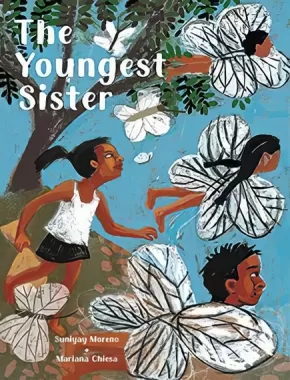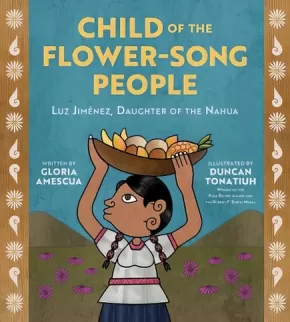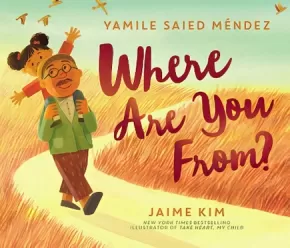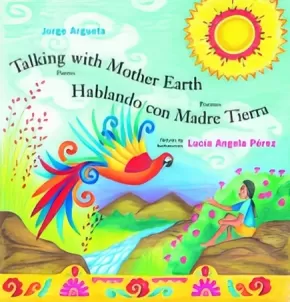
Stories from Latin America
1
-
6
of
6 Results;
Sort By
Stand as Tall as the Trees: How an Amazonian Community Protected the Rain Forest
$21.99
Artists:
Format:
Hardcover
Text Content Territories:
Indigenous South American; Indigenous Peoples in Ecuador; Kichwa (Quichua);
ISBN / Barcode: 9781623542368
Synopsis:
Synopsis:
An inspiring true story about how an activist in the Amazon worked with other Indigenous communities to protect and preserve their sacred lands and forests.
Patricia (Paty) Gualinga grew up in her Kichwa village in the Amazon of Ecuador where mystical beings called Amazanga help protect the forest. Paty traveled away from home for school until she was called back—companies that said the government sold them property were destroying her people’s lands to look for oil. The Kichwa community worked with other Indigenous groups to bring the Ecuadorian government to the Court of Human Rights.
Lyrically told and beautifully illustrated, this moving story will remind readers of the importance of nature conservation, perseverance, and standing up for your community.
Educator Information
Recommended for ages 6 to 9.
Additional Information
40 pages | 7.87" x 11.00" | Hardcover
The Youngest Sister
$22.95
Artists:
Format:
Hardcover
Text Content Territories:
Indigenous South American;
ISBN / Barcode: 9781771648752
Synopsis:
Synopsis:
“The small shall be large . . . that's how it must be.”
In the Andean foothills, a five-year-old Quechua girl is entrusted with a big job: to collect a marrow bone from the neighbor for the family soup. A stunning debut from Indigenous author Suniyay Moreno.
Picu’s family is very poor. In the dry Andean foothills, her mother must feed fourteen people—her kids, her relatives’ kids, and the hired hand’s kids—every day. One morning, Picu, the youngest sister, is sent to get a marrow bone from a neighbor. The bone will add flavor and nutrition to the lunchtime soup. Her mother warns her not to dawdle on the two-hour walk, each way, through the wild landscape.
But Picu can’t help it! She marvels at the butterflies, samples the cactus fruit, and daydreams about using the marrow bone as a football. Will the neighbor let her family keep the bone after the soup is made? Will her mother let her play with it? And will she be punished for being so late?
Picu is a child of joie de vivre and resourcefulness. This story, like Picu herself, is tough, hard, and honest. And moving. And fun.
The Youngest Sister features a glossary of Quechuan terms that are used throughout the story.
Reviews
“The vibrant illustrations are eye-catching and have the look of vigorously applied pastels. Could possibly find use within social studies units on South America.”—School Library Connections
"A memorable story alive with the voice of an Indigenous people seldom heard from." - Kirkus Reviews
Educator Information
Recommended for ages 5 to 8.
Curriculum Connections: Global Indigenous Peoples / Poverty / Cultural Diversity / Exploration & Imagination / Resourcefulness
Additional Information
40 pages | 7.00" x 9.50" | Hardcover
Aquí era el paraíso / Here Was Paradise (1 in stock, in reprint)
$19.99
Artists:
Format:
Hardcover
Text Content Territories:
Indigenous Central American; Maya;
ISBN / Barcode: 9781773064956
Synopsis:
Synopsis:
A collection of poetry by one of the greatest Indigenous poets of the Americas about the vanished world of his childhood — that of the Maya K’iche’.
Aquí era el paraíso / Here Was Paradise is a selection of poems written by the great Maya poet Humberto Ak’abal. They evoke his childhood in and around the Maya K’iche’ village of Momostenango, Guatemala, and also describe his own role as a poet of the place.
Ak’abal writes about children, and grandfathers, and mothers, and animals, and ghosts, and thwarted love, and fields, and rains, and poetry, and poverty, and death.
The poetry was written for adults but can also be read and loved by young people, especially in this collection, beautifully illustrated by award-winning Guatemalan-American illustrator Amelia Lau Carling.
Ak’abal is famous worldwide as one of the great contemporary poets in the Spanish language, and one of the greatest Indigenous poets of the Americas. Ak’abal created his poems first in K’iche’, then translated them into Spanish.
Educator Information
Recommended for ages 9+.
Dual-language in English and Spanish.
Key Text Features: foreword, biographical information, poems, translation
Correlates to the Common Core State Standards in English Language Arts:
CCSS.ELA-LITERACY.RL.4.2
Determine a theme of a story, drama, or poem from details in the text; summarize the text.
CCSS.ELA-LITERACY.RL.5.4
Determine the meaning of words and phrases as they are used in a text, including figurative language such as metaphors and similes.
CCSS.ELA-LITERACY.RL.5.5
Explain how a series of chapters, scenes, or stanzas fits together to provide the overall structure of a particular story, drama, or poem.
CCSS.ELA-LITERACY.RL.5.7
Analyze how visual and multimedia elements contribute to the meaning, tone, or beauty of a text (e.g., graphic novel, multimedia presentation of fiction, folktale, myth, poem).
CCSS.ELA-LITERACY.RL.6.2
Determine a theme or central idea of a text and how it is conveyed through particular details; provide a summary of the text distinct from personal opinions or judgments.
CCSS.ELA-LITERACY.RL.6.5
Analyze how a particular sentence, chapter, scene, or stanza fits into the overall structure of a text and contributes to the development of the theme, setting, or plot.
Excerpt from the Introduction by Patricia Aldana: "In this book we find poems about children, and grandfathers, and mothers, and animals, and ghosts, and thwarted love, and fields, and rains, and poetry, and poverty, and death. Ak'abal never pretended that life in his world was easy. The history of Guatemala is complex. It has the highest Indigenous population as a percentage of any country in the Americas. And Maya people have suffered terrible discrimination, violence and poverty since the arrival of the Europeans. But Ak'abal's poems convey how all his world's elements also came together to create a deep, rich reality.... Reading these wonderful poems can remind us that it is still possible to fight to protect this beautiful world and the people who live in and on it."
Additional Information
172 pages | 6.50" x 8.31" | 14 Colour Illustrations | Hardcover | Translated by Hugh Hazelton
Child of the Flower-Song People
$23.99
Format:
Hardcover
Text Content Territories:
Indigenous Central American; Indigenous Peoples in Mexico; Nahuas; Aztec; Nahuas;
ISBN / Barcode: 9781419740206
Synopsis:
Synopsis:
Award-winning illustrator Duncan Tonatiuh brings to life debut author Gloria Amescua's lyrical biography of an indigenous Nahua woman from Mexico who taught and preserved her people's culture through modeling for famous artists
She was Luz Jiménez,
child of the flower-song people,
the powerful Aztec,
who called themselves Nahua—
who lost their land but who did not disappear.
As a young Nahua girl in Mexico during the early 1900s, Luz learned how to grind corn in a metate, to twist yarn with her toes, and to weave on a loom. By the fire at night, she listened to stories of her community’s joys, suffering, and survival, and wove them into her heart.
But when the Mexican Revolution came to her village, Luz and her family were forced to flee and start a new life. In Mexico City, Luz became a model for painters, sculptors, and photographers such as Diego Rivera, Jean Charlot, and Tina Modotti. These artists were interested in showing the true face of Mexico and not a European version. Through her work, Luz found a way to preserve her people's culture by sharing her native language, stories, and traditions. Soon, scholars came to learn from her.
This moving, beautifully illustrated biography tells the remarkable story of how model and teacher Luz Jiménez became “the soul of Mexico”—a living link between the indigenous Nahua and the rest of the world. Through her deep pride in her roots and her unshakeable spirit, the world came to recognize the beauty and strength of her people.
The book includes an author’s note, timeline, glossary, and bibliography.
Reviews
“Gloria Amescua narrates the amazing life of Luz Jiménez with lyrical beauty that echoes the very xochicuicatl—ancestral Nahua poetics—that Luz sought to preserve for her people. Child of the Flower-Song People deftly balances fascinating biographical moments with an earnest sense of social justice for the indigenous people of Mexico. Duncan Tonatiuh’s now famous codex-style art, drawn from his own Nahua heritage, makes the story and message even more poignant.” - David Bowles
"An important window into the ravages of colonialism and the plight of the Indigenous peoples of Mexico." - Kirkus Reviews
Educator Information
Recommended for ages 6 to 10
Additional Information
48 pages | 9.00" x 10.00" | Hardcover
Where Are You From?
$24.99
Artists:
Format:
Hardcover
ISBN / Barcode: 9780062839930
Synopsis:
Synopsis:
This resonant and award-winning picture book tells the story of one girl who constantly gets asked a simple question that doesn’t have a simple answer.
A great conversation starter in the home or classroom—a book to share. When a girl is asked where she’s from—where she’s really from—none of her answers seems to be the right one.
Unsure about how to reply, she turns to her loving abuelo for help. He doesn’t give her the response she expects. She gets an even better one.
Where am I from?
You’re from hurricanes and dark storms, and a tiny singing frog that calls the island people home when the sun goes to sleep....
With themes of self-acceptance, identity, and home, this powerful, lyrical picture book will resonate with readers young and old, from all backgrounds and of all colors—especially anyone who ever felt that they don’t belong.
Reviews
"Lyrical language and luminous illustrations. An ideal vehicle for readers to ponder and discuss their own identities." —Kirkus (starred review)
"An enchanted, hand-in-hand odyssey [and] opportunity to acknowledge and celebrate the many, many backgrounds, roots, histories, of those who live in these United States." —Shelf Awareness (starred review)
"A much-needed title that is a first purchase for libraries and classrooms." —School Library Journal
"This touching book addresses a ubiquitous question for children of color, and in the end, the closeness between the girl and Abuelo shows that no matter the questions, she knows exactly where she’s from." —Booklist
"Although the book begins as a gentle riposte to narrow cultural and ethnic categorizations, its conclusion reaches out to all readers, evoking both heritage and the human family." —Publishers Weekly
Educator Information
Recommended for ages 4 to 8.
Themes / Subjects: Self-Acceptance; Identity; Home; Diversity; Immigration/Emigration; Prejudice
Additional Information
40 pages | 10.00" x 8.50" | Hardcover
Talking With Mother Earth (14 in Stock) - ON SALE
$14.00 $18.95
Artists:
Format:
Hardcover
Text Content Territories:
Indigenous Central American; Nahuas;
ISBN / Barcode: 9780888996268
Synopsis:
Synopsis:
Raw, honest and powerful, these moving bilingual poems by noted Salvadoran poet Jorge Argueta explore a young native boy's connection to Mother Earth and how he is healed from the terrible wounds of racism he has endured. Tetl has learned from his grandmother about the spirituality of his ancestors, about how they viewed the earth as alive with sacred meaning. This helps him move from doubt and fear, created by the taunts of other children, to self-acceptance and a discovery of his love for nature.
Mountains, wind, corn and stones all speak to Tetl, almost seeming to vibrate with life. He feels deep roots in them and, through them, he learns to speak and sing. They reveal his Nahuatl self and he realizes that he is special, beautiful and sacred.
These gripping poems have something to teach us all, perhaps especially those who have been either intentionally or casually cruel or racist, as well as those who have been the victims of racism.
Crudos, honestos e impactantes, estos conmovedores poemas bilingües por el aclamado salvadoreño Jorge Argueta exploran la relación de un joven nativo con la Madre Tierra y de como fue curado de las terribles heridas causadas por el racismo que ha tenido que aguantar. Tetl ha aprendido de su abuela sobre la espiritualidad de sus ancestros, sobre como ellos veían la tierra como un ser vivo con un sentido sagrado. Esto lo ayuda a pasar de la duda y el miedo, creado por las burlas de los otros niños, a la aceptación de sí mismo y al descubrimiento de su amor por la naturaleza.
La montañas, el viento, el maíz y las piedras le hablan a Tetl, parece casi que vibran de vida. El siente profundas raíces en ellos, a través de ellos, y aprende a hablar y cantar. Ellos le revelan su parte Náhuatl y él se da cuenta de que es especial, bello y sagrado.
Estos poemas apasionantes tienen algo que enseñarnos a todos, quizás especialmente a aquellos que intencionalmente o sin quererlo han sido crueles o racistas, como también a aquellos que a su vez han sido víctimas del racismo.
Additional Information
36 pages | 8.94" x 9.56"
Sort By












